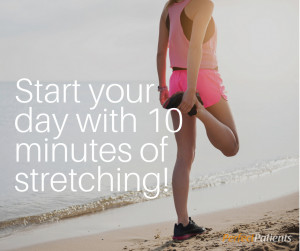
Many of us athletes (a person who is proficient in a sport or physical exercise – anyone from a jogger to an Olympic competitor!!) are aware that we should be stretching and maintaining a good level of flexibility. It quite often is not the most exciting aspect of our chosen sport, but it is one of the most important activities we should all be doing. But why, when and how often?
WHY: If a muscle or muscle group begins to become inflexible, this can cause tension through your body. This can lead to compensations in how your body holds itself, and over time, biomechanical compensations which can lead to injuries. Some of you may know that when Dr Laura broke her ankle, after wearing the ‘moon-boot’ cast for 4 weeks, she developed compensations through her body, which then translated into her running gait (the biomechanics of running). This is something that Dr Laura has spent a lot of time on to restore the proper function and biomechanics, to improve her running technique and remain injury free. Your brain and body desire balance, ease and equality throughout your body – when this is disrupted due to tensions and a lack of flexibility, your body scrambles to help, most of the time causing negative compensations in your body.
WHEN: Research suggests that the well-known and traditional static stretching (holding a comfortable stretch of a muscle over a period of time) BEFORE exercise is actually detrimental to sports performance. The type of stretching that is beneficial prior to exercise is called dynamic stretching. This involves using momentum and movement to stretch a muscle. Dynamic stretching increases the range of motion of the joints near the stretched muscle, increases blood and oxygen flow to the soft tissues ready for activity and exercise. If you would like some examples of dynamic stretches, ask Dr Laura – she is more than happy to help!
HOW OFTEN: Another time that you might think about stretching is in a yoga, Pilates or tai chi class. This is where research suggests we can make the biggest changes to our flexibility, especially if we make this common place in our routines. The more regular this routine, the longer lasting the improvements in flexibility will be. Participating in these classes can also reduce your blood pressure, reduce stress, improve balance and naturally improve your flexibility. Research suggests you should be taking a structured flexibility session at least twice per week, and if you are involved in a lot of sport, you should increase this frequency accordingly.
Chiropractic care helps facilitate your flexibility. Many people report that they have improved range of motion and flexibility after chiropractic care. If there are compensations throughout your body, chiropractic care also helps manage these and restore balance and ease to your body.
Chiropractors are specialists in assessing and correcting spinal subluxations. Subluxations are when your spinal joints have less motion, reduced mobility, or function. This can be caused by tightness in muscles or ligaments, sports injuries or over exercising. Subluxations reduce how well your nerves and nervous system communicate and relay information to your brain, causing your brain to function poorly. By correcting your subluxations, you will have a better functioning brain and nervous system which could lead to your body being in a better state to be able to adapt through your sport and exercise. There has also been lots of research into sports performance improvements and chiropractic care – Usain Bolt regularly had chiropractic care throughout his sporting career.
Bibliography:
- Michael R Bracko (2002) Can Stretching Prior To Exercise and Sports Improve Performance and Prevent Inury? Health and Science Journal Vol 6, No 5:17-22
- MP Mchugh, And CH Cosgrave (2009) To Stretch or Not to Stretch: The Role of Stretching in Injury Prevention and Performance. Scandinavian Journal of Medicine and Science in Sports. 20:169-181
- G Gremion (2005) The Effect of Stretching on Sports Performance and The Risk of Injury: A Review of The Literature. 53(1)6-10
- TJ Herda, JT Cramer, ED Ryan Et Al. (2008) Acute Effects of Static Versus Dynamic Stretching on Isometric Peak Torque, Electromyography and Mechanomyography Of the Biceps Femoris Muscle. Journal of Strength and Conditioning Research 22(3) 809-817
- PA Hough, EZ Ross And G Howatson (2009) Effects of Dynamic and Static Stretching on Vertical Jump Performance And Electromyographic Activity. Journal of Strength and Conditioning Research. 23(2) 507-512
- https://www.mayoclinic.org/
- https://www.hprc-online.org/
